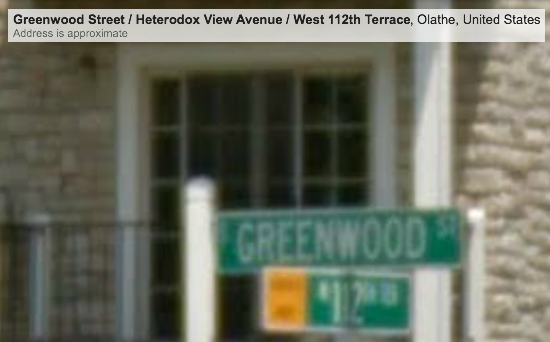I’ve wanted to feature Trap Streets on 12MC for the longest while. I began the initial research and started writing an opening paragraph probably a half-dozen times over the last five years. It remained on my topic list, surviving various purges in the vague hope that someday I might find an opportunity to discuss it. Inherently, how does a geo-oddity site dependent upon visual imagery begin to approach something that by definition does not exist?
Heterodox Recap
Let me recap recent developments. I posted another installment of Odds and Ends a couple of days ago, mentioning reader Nigel’s curious discovery of Heterodox View Avenue in various locations throughout the United States. I conducted a basic search and I couldn’t provide an explanation. At the time I observed, “Heterodox View Avenue — and it was always Heterodox View Avenue; not street, not drive, not boulevard, only avenue” and I couldn’t understand why. Neither could I fathom a reasonable explanation for any avenue named “heterodox” in general, a term defined roughly as an unconventional opinion. It all seemed odd and vaguely out of sorts.
Three 12MC readers, Wangi, Craig, and Rhodent each posted comments in quick succession independently. Perhaps, they suggested, multiple appearance of Heterodox View Avenue were meant to serve as trap streets.
Trap streets don’t serve as literal traps — although those in fact do exist (primarily in Canada) — instead they serve as traps for copyright violators. Cartographers historically drew minor, insignificant errors into their maps to deter others from stealing their works. Often errors took the form of small, fictional one-block streets. Access roads through shopping center parking lots, as with several Google Maps’ appearances of Heterodox View Avenue, seemed to fit that definition rather nicely on a theoretical level.
Lenexa
Two of the comments focused specifically on Heterodox View Avenue in Lenexa, Kansas. That was the only example where one could clearly read actual signage in Street View, and cross-reference it to the underlying map. I took a screen print of the image:

Don’t be too concerned about the address being listed as Olathe in the image. The spot was Olathe by about 500 feet from its border with Lenexa, so either may be possible from a postal service perspective. More importantly, compare the confluence of street names with the (blurry) image. Notice W. 112th Terrace.
Meanwhile, Google Maps displayed that exact same street as Heterodox View Avenue. Ground images completely contradicted that claim. It was not Heterodox View Avenue. Google Maps also got the western cross-street wrong. It’s actually W. 113th Street.
I compared the location with a couple of other online mapping tools.
OpenStreeMap labeled W. 112th Terrace correctly, although paradoxically it also whiffed on the western cross-street.
Only Bing got it right, with W. 112th Terrace to the east, W. 113th Street to the west, and no sign of Heterodox View Avenue anywhere.
Trap or Inaccuracy?
I turned to an overview of trap streets presented on OpenStreetMap where they were called Copyright Easter Eggs. OSM viewed them as unnecessary because the site incorporated “a very unique and distinct fingerprint evident in the data coverage and details included.” Thus, for example, OSM was able to determine that Apple had lifted data without attribution in 2012 without having to resort to “introduced errors.” Trap streets once had meaning in the paper mapping era although they’ve become quaint anachronisms in the digital age.
One must also consider that map inaccuracies can derive from many sources. Trap streets likely form an inconsequential percentage. I’ve noticed frequent innocent errors in every online mapping tool with nothing suspicious intended by the authors. Mistakes happen. I’ve also observed numerous cases of “paper streets,” including entire subdivisions, which were planned at one time and never constructed. Let’s also not discount the possibility of pranks intended as harmless insertions by bored or playful cartographers.
Were the appearances of various Heterodox View Avenues sufficient evidence of genuine trap streets in Google Maps? It seemed more plausible than finding several unrelated, unintentional errors having the same exact name, or paper streets overlaid upon actual streets, or a not particularly clever prank. I doubt Google would ever admit to the existence of trap streets even if they were true so we will never know. It will be interesting to watch what happens now that Heterodox View Avenue has been outed.
Trap Street is also a movie!
Search on trap street, and behold, one will stumble upon a 2013 Chinese movie with that title in its English version. The Internet Movie Database provided a brief description that sounded intriguing from a geo-geek perspective:
“In a southern city of China, a digital mapping surveyor encounters a mysterious woman on an unmappable street… He learns that the data he collected of the street will not register in the mapping system. The street has disappeared as if it never existed. Desperate to reconnect with the mysterious woman he continues his investigation of the unmappable street only to discover something that will change his life forever.”
While the movie has screened in Canada, Russia and the UK, it does not have a US release date as of the time I write this (Nov. 24, 2013). It will debut next at Coca-Cola Plaza in Tallinn, Estonia as part of the Tallinn Black Nights Film Festival, on November 26. Tickets were still available this morning. I’m half-tempted to buy one even though I’ll never be able to attend (road trip to Estonia, anyone?). Maybe the director, Vivian Qu, will stumble across this page while Googling herself and invite me to the US premier.
I guess I should start learning Mandarin. I hate subtitles.

Leave a Reply